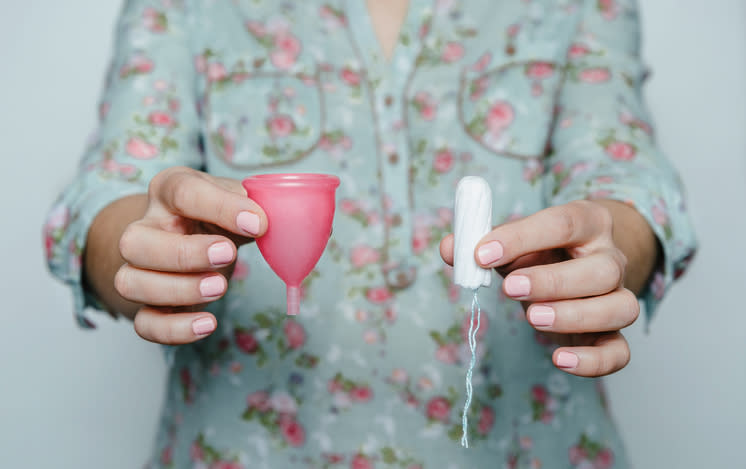Are Menstrual Cups Better For Your Body Than Tampons?

[Photo: Getty]
Of all the little costs that chip away at your hard-earned gin money, tampons are unquestionably the worst. So instead of forking out two or three quid a month on ‘riding the cotton pony’, should you shell out £20 for a menstrual cup?
For anyone who isn’t yet acquainted with menstrual cups, here’s what you’ll be dealing with:

[Photo: Getty]
Menstrual cups are made of silicon and are folded before being inserted into the vagina where they re-expand. You can re-use your cup for years (good for both the environment and your wallet) but are they actually better for your body than a good old fashioned binnable bit of cotton?
In a word, yes.
“Unlike tampons, menstrual cups keep all your other healthy vaginal fluids right where they should be: in your vagina,” says Anna Druet, research scientist at menstrual health app, Clue. “Tampons absorb anything they can get their cotton-y fibres on. This includes healthy bacteria, hydration and lubrication.”
Ever yanked out a tampon after only wearing it for an hour? Yup, it hurts for a reason.
“Tampons also cause friction in the vagina, especially when they are too absorbent for the amount of blood flow,” Druest adds. “This can cause little tears in the delicate vaginal wall.”
According to Dr Vanessa Mackay, spokesperson for the Royal College of Obstetricians and Gynaecologists, both tampons and menstrual cups are safe if used correctly but tampon use carries a very low risk of Toxic Shock Syndrome (TSS).
“While scientists recognise a link between TSS and tampon use, there is no proven evidence as to why this occurs,” she explains. “It’s believed that leaving a tampon in your vagina for a prolonged time can create a breeding ground for bacteria. Another theory is that the fibres of the tampon may scratch your vagina, allowing bacteria or the toxins to enter the blood.”
There’s good news for the silicon lovers among us, however. “There is less chance of developing TSS if a women uses a menstrual cup, as they are non-absorbent, do not irritate the vaginal mucosal tissue and don’t change the vaginal flora,” says Dr Mackay.
Vaginal mucosal tissue aside, many women find menstrual cups a more practical sanitary product than their stringed counterparts.
“A menstrual cup seemed like a cheaper option in the long term,” says Louisa, a 23-year-old bar tender. “I’ve found that the cup is also less messy than using tampons or pads.”
Dr Mackay also points out that cups need changing every 4-12 hours, whereas tampons must be changed every 4-8. However, she also notes the importance of keeping your cup clean.
She says: “Women should always clean their menstrual cup between uses, making sure the air holes at the top of the cup are clear of fluid. Between periods, the cup should be thoroughly washed and sterilised using boiling water and stored in a clean space.”
As long as you’re willing to see your period up close and give a piece of bloody silicon a regular rinse, ditching the cotton for a cup could be a great move for both your wallet and your vagina.
There’s A Reason Why Hangovers Feel So Much Worse When You’re Older


